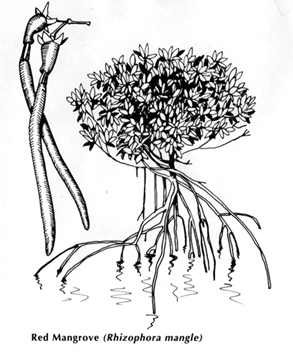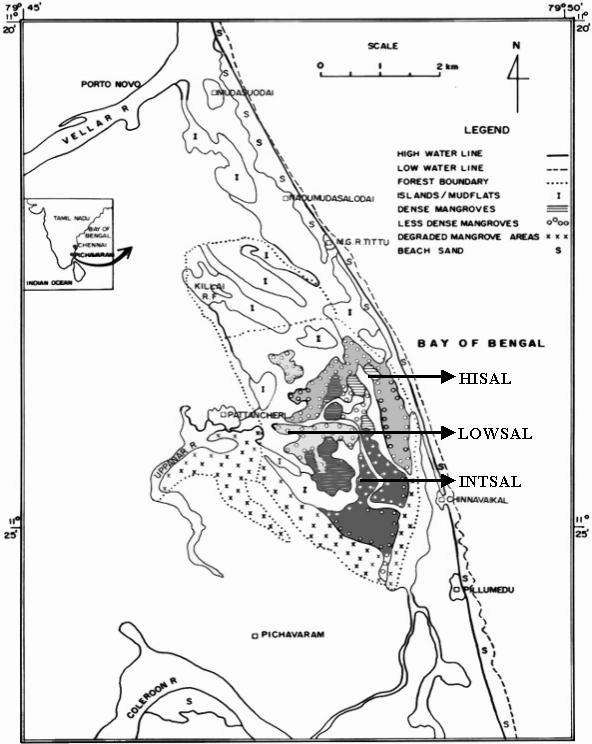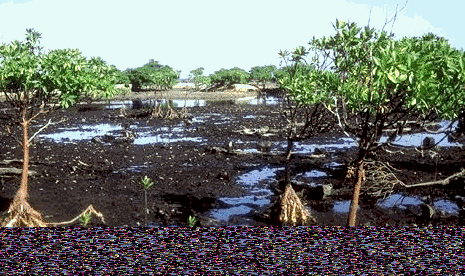|

|
Pichavaram
Mangroves:
The
Pichavaram Mangrove along the South east coast of India covering an
area of 1100 ha will be studied for two years from September 2002 until
August 2004.
Fig: Pichavaram mangrove ecosystem along the Southeast coast of India

Located at the northern
end of the Cauvery delta at latitude 11°27' North and longitude 79°
47' East, the Pichavaram mangrove is an estuarine type, connected to
the Vellar estuary in the north and the Coleroon estuary in the south
with a well developed backwater system. In all, 51 islets were identified
in the mangrove area, which are separated by intricate waterways connecting
the two river systems. The total area of the wetland of the Vellar-Pichavaram-Coleroon
estuarine complex is about 2335.5 ha, of which only 241 ha (i.e. 10.32%)
is occupied by dense mangrove vegetation (Krishnamoorthy, 1996). Nearly
593 ha (25.41%) of this wetland are occupied by halophytic vegetation
like Suaeda, 262.5 ha (11.24%) by barren mudflats and
1238.5 ha (53%) by barren high saline soil.
fig: Mangrove Swamps of South India

Zonation and species density:
This mangrove area is colonized by 14 exclusive mangrove species,
dominant among them are the Rhizophora apiculata, Rhizophora mucronata,
Avicennia marina, Avicennia officinalis Excoecaria agallocha etc.
In addition, there are 18 associated species mostly shrubs of which
Suaeda maritima a true halophytic species, is dominant. The
zonation of the mangrove flora at Pichavaram is classified on their
distribution pattern in three zones namely: the Rhizophora zone, the
Avicennia zone and the Suaeda zone. In all the areas, the Rhizophora
zone occurs as a narrow strip along the tidal creeks and channels. In
the inner estuarine region, the breadth of the Rhizophora zone is ~4m,
whereas in the seaward region, it extends to ~10m. Out of the 14 important
species in this mangrove ecosystem, barring Avicennia marina, Excoecaria
agallocha, Rhizophora mucronata and Acanthus ilicifolius, the distribution
of the remaining species, are restricted to a narrow zone. This indicates
the fragility of the species and diversity of the mangroves to external
stresses such as the rapid development of shrimp farms in areas close
to the mangroves. It has also been observed that the community structure
of this mangrove is influenced by the magnitude and periodicity of tides,
hydroperiod, nutrients and salt accumulation.

Hydrodynamics:
The Pichavaram
mangrove is separated from the Bay of Bengal by a narrow sand bar during
summer and is periodically flooded by the incoming tidal waters. Apart
from the flushing of the neritic waters from the Bay, the direct entry
of freshwater into the mangrove ecosystem is through the Coleroon and
Vellar rivers, the former being more dominant. This "fringe" mangrove
is a protected natural marine sanctuary and receives freshwater from
the two riverine sources and through rainfall. Additionally, it receives
significant amounts of agricultural runoff (Table 1) from the adjacent
paddy fields, the effects of which may impact the mangrove area to as
large extent.
|




